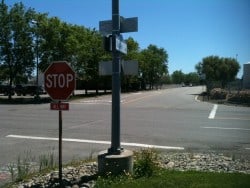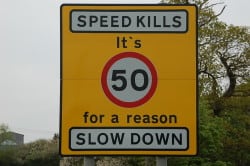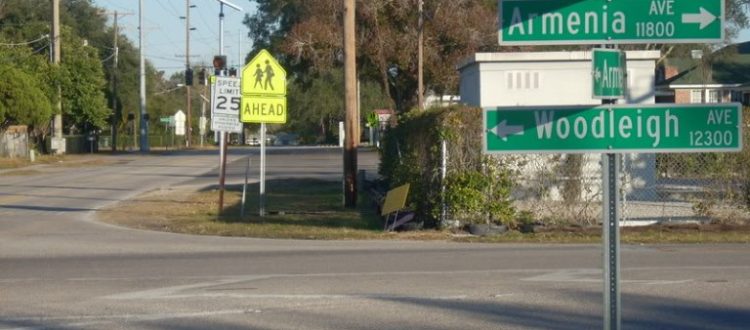Is traffic in the intersection safe? And, putting up traffic signs as approved by your local government.
Question: Will traffic signs make an intersection safer?
 Generally, yes. Unless it had a traffic light and now you’re replacing it with signs. Of course, if there’s little traffic at that intersection anyway, it won’t make much actual difference where safety is concerned.
Generally, yes. Unless it had a traffic light and now you’re replacing it with signs. Of course, if there’s little traffic at that intersection anyway, it won’t make much actual difference where safety is concerned.
The newer USDOT codes, and I believe most “First World” nations as well, though, require the “diamond grade” reflective materials to be the basis for most intersection signs, so it’s almost like having a traffic light anyway.
Now, if there was no control at an intersection previously (a.k.a. an “unmarked intersection”), then it will be very likely that it is now a 4-way stop or that one direction will consistently have the right of way, and the other direction will be required to stop. Either way, if it is a semi-busy street or road, stop signs should make that intersection safer.
Question: How does the County decide where to install traffic signs?
Good question, and I can only tell you that they make their decisions, in most cases, based on traffic levels and safety. Although I’ve seen them install lower speed limit signs in some areas where I suspect revenue, not safety, was the goal.
Speed Limit Signs
 For instance, in an area where there has been a lot of developing going on, and traffic has increased significantly over the past year or two, with lots of families with young children moving into an area, the speed limits on the main road alongside the development may be changed to 35MPH from 45 or 50MPH in order to reduce the risk of a child being injured that inadvertently darts in front of a car to grab an errant Frisbee. Or similar. An auto traveling at 35MPH has a much shorter stopping distance than one traveling 50MPH.
For instance, in an area where there has been a lot of developing going on, and traffic has increased significantly over the past year or two, with lots of families with young children moving into an area, the speed limits on the main road alongside the development may be changed to 35MPH from 45 or 50MPH in order to reduce the risk of a child being injured that inadvertently darts in front of a car to grab an errant Frisbee. Or similar. An auto traveling at 35MPH has a much shorter stopping distance than one traveling 50MPH.
Stop Signs
Of course, in the new development, there are streets which will exit the development to the main road mentioned above. Obviously, the county will require STOP signs at all intersections involving a main road. The speed limit in most developments is 25MPH, so a large STOP sign would be overkill. Our county requires a 30” STOP sign at these intersections. Higher speed intersections require larger STOP signs.
School Zone Signs
In this new development, it may be that a new grade school is also built to handle all the new children coming into the development. The USDOT regulates, along with cooperation with the various US states, the signing of all school districts with Hi-intensity “diamond” grade reflective signage on the appropriate alodized or anodized aluminum sign blanks. Most school zone signs are mandated by the USDOT with a few additional signs being mandated by the various state DOT’s as well.
Side note: Alodization/Anodization is a chemical process which helps aluminum to resist corrosion. Little-known Fact: Aluminum corrodes at a faster rate than steel rusts.
School zones are the most heavily signed areas, in my view, of any streets in the US, and likely Canada, Europe, and the Commonwealth nations are similar in their sign regulations for school districts. I don’t know about the above mentioned regions, but in the US, these are also the most heavily patrolled areas as well, both because of safety concerns, and since 2008, probably as a driver of revenue for the county as well.
That’s a pretty long answer to your short question, but hopefully encapsulates the answer somewhat succinctly! To see more on custom making of alodized, or anodized, traffic sign markers, go here.
Popular Posts:




